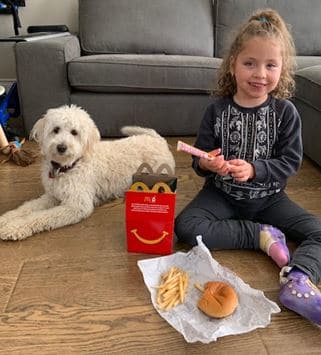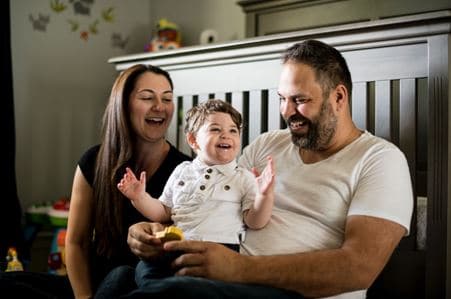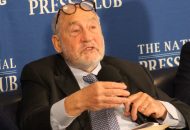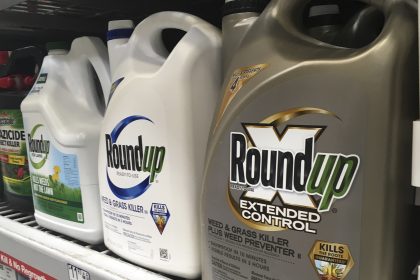Foundation Opens Door to ‘Whole Different World’ for Children with Ultra Rare Diseases

WASHINGTON – It began as a story no new parent wants to tell.
“I always say that the day my daughter was born was the happiest day of my life, because that was the only day I didn’t worry about her,” the woman on the other end of the line said.
Speaking in a strong, clear voice that still bore hints of the emotional roller coaster her family has been through, Schillann Rodriguez then went on to describe what it was like to find out her daughter, Rian, suffered from one of the rarest medical conditions in the world.
Little Rian, the mother would learn, is just one of fewer than 150 children in the world that suffer from Aromatic I-amino Acid Decarboxylase Deficiency, an inherited genetic disorder that affects the way signals are passed between certain cells in the nervous system.
“The day after she was born, I knew something was wrong,” Rodriguez said. “She was sleeping too much. She was having feeding difficulties. But all of the doctors around us said, ‘Stop worrying. She’s dirtying her diapers and she’s eating enough to gain weight. She’s okay.'”
Rodriguez would come to learn that her experience is the norm when it comes to AADCd. The condition is so rare, it often goes unrecognized. On a day to day basis, doctors just aren’t looking for it.
Four months later, Rian’s pediatrician confirmed Rodriguez’s worst fears, suggesting the child be taken to a neurologist.
“That’s basically when our world came crashing in,” Rodriguez said. “That’s when we went from being a typical, young, healthy family to … facing this monster of fear about our daughter’s future.”
Between the ages of four and 11 months, Rian would be tested for well over 500 conditions.
Most of the testing was invasive. There were muscle biopsies, nerve conduction studies, and blood test after blood test.
All the while, Rian’s symptoms grew steadily worse. It was almost impossible for her to hold her head up, and she had difficulty moving. She also began to feed poorly and experienced involuntary writhing movements of her limbs.
“Finally, through a quite progressive test called exome sequencing, which looked at her genetic makeup, they found she had this disease, AADCd,” Rodriguez said.
Rian was a month away from her 1st birthday. And for the first time, Rodriguez said, she felt a renewed sense of hope.
“The thing about the day of diagnosis is, they give you an idea … they can finally give you a name for what it is … and when things are so rare, you’re blessed to be able to call it something,” she said.
The diagnosis also, in an instant, made Rian and her family part of a community fighting not just AADCd, but a whole host of ultra rare diseases.
This is critically important because while certain drug treatments can blunt the worst effects of these conditions for a time, the only known transformative and potentially life-saving genetic therapy costs on average, about $2.8 million.
And it’s a one-time proposition. According to Dr. Krystof Bankiewicz, perhaps the world’s foremost expert on AADCd, the pioneering brain delivered gene therapy treatment he performs can only be done once. A second attempt could actually worsen the condition and hasten the child’s death.
After learning the name of her daughter’s condition, Rodriguez was ready to fight. Taking to the internet, she learned of the AADC Research Trust, a U.K.-based trust dedicated to raising funds so that AADCd children can undergo the gene therapy treatment.
The trust in turn put her in touch with Dr. Bankiewicz, who holds an M.D. from Jagiellonian University in Krakow, Poland, and a Ph.D., D.Sc., from the Institute of Neurology and Psychiatry in Warsaw.
Bankiewicz trained at National Institutes of Health in Bethesda, Md., and he is now a world-renowned expert in neuro-restorative medicine. His work in AADCd is proving highly successful not only in stopping the progression of the disease, but in restoring function to children.
Schillann traveled to conferences to hear him speak, and he told her of another group that could help her get the treatment she needed for her daughter, the Columbus Children’s Foundation.
CCF is a registered 501(c)(3) nonprofit organization on a mission to ensure equitable and affordable access to the most effective gene therapy solutions for children with ultra-rare genetic diseases.

The nonprofit was founded in Valencia, Spain, in 2017 out of a recognition that because diseases like AADCd are so rare, traditional commercial development of treatments are either overlooked or too costly to be feasible.
A U.S. chapter was established in Chapel Hill, N.C., a year later.
Columbus Children’s Foundation creates hope for affected families by applying a nonprofit model to accelerate gene therapy treatments for these devastating diseases.
Through strategic partnerships with other foundations, industry, patient groups and philanthropic donors, it leverages critical scientific and funding resources to fight these ultra-rare diseases in children.
CCF’s four core focus areas include providing financial support to accelerate the advancement of gene therapy clinical trials for ultra-rare genetic diseases; ensuring access to manufacturing capacity and expertise — a significant obstacle for ultra-rare gene therapy programs — supporting the open-source data model and standard protocols across the broader gene therapy community; removing the hurdles for children and families to access life-altering clinical trials around the world.
The Columbus Children’s Foundation has developed a manufacturing partnership that specifically gives access to lower-cost captive manufacturing for ultra-rare disease programs.
Officials with the organization said access to manufacturing is often a significant slowing step for these as supply is not generally available. This manufacturing partnership is a significant part of CCF’s mission to accelerate treatments; without it, these programs will stall and children will die.
Coronavirus Slows Progress
Of course, like every other aspect of contemporary life, the coronavirus outbreak has dramatically slowed treatment for children with ultra rare genetic diseases.
Among them is Michael Pirovolakis, who has Spastic Paraplegia 50, also known as “progressive cerebral palsy,” of which there are only 61 known cases in the world.
Terry Pirovolakis, Michael’s father, recalls the birth of his third child as being trouble free. Within hours of the delivery, mother and baby were resting at home in the care of a midwife.
But about six months after Michael was born, his parents noticed he wasn’t meeting the milestones babies typically reach by that age. As in the Rodriguez’s case, doctors initially assured the Pirovolakis they had nothing to worry about.
Months later, even the doctors were concerned. Michael’s head appeared to stop growing and his muscle tone was disappearing.
Because Terry Pirovolakis had traveled to Latin America on business, doctors suspected Zika, which was very much in the news at the time, might be the culprit. However, testing for it and other infectious diseases came back negative.
Genetic testing followed. Then came the phone call.
“By that point, we had seen a number of doctors and they’d always called and simply given us the results on the phone,” Pirovolakis said. “This time they told us to come … and to be honest, our first reaction was to wait. After all this time, we were afraid to find out what they’d found.
“Ultimately, we said, ‘What does it matter? Why are we hesitating? If he had a disease, he’s going to have it.’ On April 2, 2019, they told us Michael has SPG50,” the boy’s father said.
Pirovolakis told The Well News he still clearly remembers that sense that a fog had descended on his family when he was told how rare the condition was and that there was no known treatment.
“It was like a piece of my soul was taken from me,” he said.
By the time he left the doctor’s office, he was on a mission. From that point on, he said, “I researched everything. I spoke to experts in the field. And I came away knowing exactly what I had to do — create a gene therapy, and do so as quickly as possible if I was going to be able to help my son and other children.”
Everyone Pirovolakis knew felt for him, but at the same, “told us we were crazy. This was just too big an effort to undertake.
“Fortunately, we met a few really nice, really smart scientists along the way, and they kind of guided us down the path we needed to be on,” he said. “Later, I flew to Washington and met with six of the world’s seven experts on SPG50, and by the time I went home to Texas, I’d hired a scientist, Dr. Steven Gray, to develop the gene therapy.”
Just as Dr. Bankiewicz had done with the Rodriguez family, Dr. Gray made clear to Pirovolakis that a long, hard road lay ahead and that there were no guarantees.
On top of everything else, Pirovolakis and his wife would have to raise $3 million to $5 million to provide the treatment to Michael and hopefully, several other children.
“That was daunting,” Pirovolakis said. “Even if we sold our home and liquidated all of our assets, we wouldn’t be able to raise enough money to save Michael. So we established a GoFundMe account, and did golf tournaments and barbecues … and collectively, as a community, we raised $1.7 million in a year and a half.”
The next step was to establish a formal charity, which took time. It was then, just as the charity was getting under way, that the coronavirus pandemic took hold.
“Our fundraising stopped. And government resources were being redirected to battling the coronavirus, and it was at that point in our journey that we met the Columbus Children’s Foundation,” Pirovolakis said.
At this point, due to the scarcity of resources caused by the pandemic, the cost of creating the gene therapy had risen to an estimated $7 million, “which would be unrealistic for a family or a small foundation like ours to raise,” he said.
At a conference in Californian, Pirovolakis met Laura Hameed, executive director of the Columbus Children’s Foundation. “We got to talking about our cause and our journey, and she said, ‘when you get a safe treatment, reach out to me’ … and a couple of months later, I did.”
Earlier this week, Hameed explained the Foundation’s approach to The Well News.
“I think it’s really critical to apply a nonprofit mindset to these situations,” she said. “And by that what I mean is, a nonprofit mindset is focused on ‘How do I deliver treatment to kids?’ and we don’t have to balance the potential answer to that question with the return on investment expectations from investors.
“We leverage donors, we leverage industry partners, we leverage government, all to accelerate the speed at which we bring treatments forward … while investing in programs that would be deemed not investable by the private sector,” Hameed said.
“Ultimately, I would say we fill a market gap for these ultra small patient populations, but we’re not starting from scratch, we work with other foundations, many of them started by parents, who have raised the funding for basic research and development,” she continued. “Our role is to accelerate the process by providing them with access to expertise and manufacturing, which is often the biggest hurdle for them to get over.”
“Now here we are trying to save these 61 kids together,” Pirovolakis added. “If everything goes well and we’re super lucky — and we raise our remaining 1.4 million — we should be treating as many as 43 kids in the next year,” he said.
Anxious Moments
Before Rodriguez and her husband learned of the Columbus Children’s Foundation, they were repeatedly told time was not their friend, and that in all likelihood the little girl they’d just welcomed to their home would never see five candles on her birthday cake.
With the help of Dr. Bankiewicz, from CCF, the family flew to Poland in September 2019, for Rian’s surgery.
“I remember turning to my husband at one point and saying, ‘You know your child is gravely ill when you’re traveling to a foreign country so they can have trial brain surgery … and you’re excited about it,’” Rodriguez said.
The night before the surgery, Dr. Bankiewicz and his team walked the family through all the risks.
What was about to occur was an eight-and-a-half hour surgery on a very medically fragile child, he said. She could suffer brain bleed, cardiac arrest, respiratory failure. It was very important that she and her husband were aware of all the risks.
“And I said, ‘With all due respect, the risk we would take by not giving her the chance of this intervention is a heck of a lot bleaker. The only alternative is for her to lie in a hospital bed in my living room until she dies. We don’t have another choice.'”
For all her resolve in the moment, Rodriguez admitted she was “absolutely frightened.”
“But we had faith in Dr. Bankiewicz and we had faith in his team,” she said.
A month and a half after her surgery, Rian lifted her head up from her reclining wheelchair. On Christmas Eve, 2019, she reached out for the first time in her life to play with something.
“We were losing our minds with excitement,” Rodriguez said of how she and her husband felt.
But better was yet to come. Soon, she was able to eat solid food, “which she could never do before,” and nine months after her surgery Rian was able to sit independently for the very first time.
“I tear up thinking about it,” Rodriguez said as her voice cracked.
“For so long just the ability to see your child sit independently and play was such a far off dream for us … and now it’s our everyday reality,” she said. “That might not sound like a lot, but from where we came from to where we are today, it’s a whole different world,” she said.

























